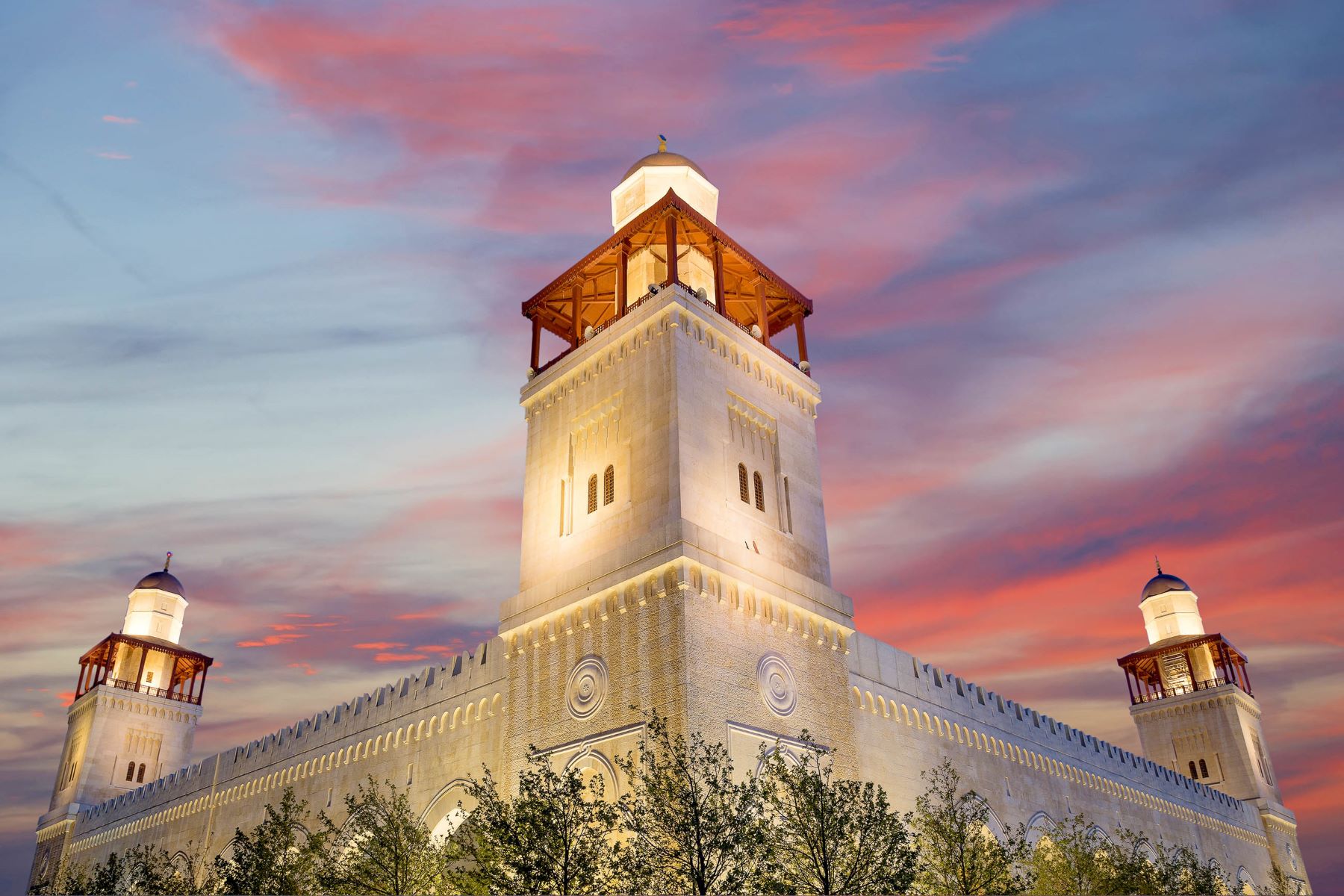
The King Hussein Mosque, located in Amman, Jordan, is a captivating and iconic landmark that holds significant cultural and historical value. This magnificent mosque, also known as Al-Hussein Mosque, is not only a place of worship but also serves as a symbol of the rich heritage and religious tolerance of the Jordanian people.
Constructed in 1924 during the reign of King Abdullah I, the mosque is dedicated to his grandfather, King Hussein bin Ali, the founder of modern Jordan. Its distinctive Ottoman-inspired architectural design, adorned with intricate marble detailing and a striking blue dome, makes it a standout attraction in the heart of downtown Amman.
As you explore the intricate beauty of the King Hussein Mosque, you’ll also discover some fascinating and surprising facts that add to its allure. From its historical significance to its architectural marvels, let’s delve into 15 surprising facts about the King Hussein Mosque that will deepen your appreciation for this grand structure.
Key Takeaways:
- King Hussein Mosque in Amman is a stunning blend of traditional and modern architecture, symbolizing unity and cultural richness, and offering a peaceful oasis for visitors to find serenity and reflection.
- Gifted by Morocco, King Hussein Mosque is the largest in Amman, featuring a remarkable mihrab, a peaceful courtyard, and a contemporary Islamic library, welcoming visitors of all backgrounds to explore its beauty and cultural significance.
The Majestic Architecture of King Hussein Mosque
The King Hussein Mosque, located in the heart of Amman, showcases breathtaking Islamic architecture that leaves visitors in awe. The intricate designs and grandeur of the mosque reflect the rich cultural heritage of Jordan. With its towering minarets and stunning domes, the mosque stands as a testament to the architectural prowess and devotion of the Jordanian people.
The Largest Mosque in Amman
Did you know that the King Hussein Mosque is the largest mosque in Amman? Spanning over an impressive area, the mosque can accommodate thousands of worshippers at any given time. Its expansive prayer hall, adorned with beautiful calligraphy and chandeliers, provides a serene atmosphere for prayer and reflection.
A Gift from Morocco
One of the most fascinating facts about King Hussein Mosque is that it was a gift from the late King Hassan II of Morocco to the late King Hussein of Jordan. The completion of this magnificent mosque not only solidified the strong bond between the two nations but also symbolized the unity of the Muslim community.
A Blend of Architectural Styles
The design of King Hussein Mosque is a harmonious blend of various architectural styles, combining traditional Islamic elements with modern influences. The mosque’s facade features a combination of white stone and striking geometric patterns, showcasing the mastery of craftsmanship.
The Remarkable Mihrab
The mihrab, a niche in the mosque indicating the direction of Mecca, is one of the most remarkable features of King Hussein Mosque. Elaborately adorned with intricate calligraphy and decorative tiles, the mihrab serves as a focal point for worshippers during prayer.
An Impressive Dome
The main dome of King Hussein Mosque is a marvel to behold. Its magnificent size and beautifully crafted interior make it a prominent feature of the mosque’s architecture. As sunlight filters through the stained glass windows, the dome casts a mesmerizing glow inside the prayer hall.
A Peaceful Courtyard
Within the mosque complex, you’ll find a tranquil courtyard adorned with lush greenery and decorative fountains. It serves as a peaceful oasis, inviting visitors to relax and immerse themselves in the serenity of the surroundings.
A Hub for Islamic Studies
King Hussein Mosque not only serves as a place of worship but also functions as a center for Islamic studies. The mosque houses various classrooms and facilities dedicated to educating and enlightening individuals about the principles and teachings of Islam.
An Open Door Policy
With its open-door policy, the King Hussein Mosque welcomes visitors from all over the world, promoting cultural exchange and understanding. Non-Muslim visitors can explore the mosque’s architectural marvels and learn about the values and traditions of Islam.
The Symbolic Prayer Hall
The prayer hall of King Hussein Mosque is not only a place for prayer but also rich in symbolism. Its meticulously designed carpets, intricate lighting fixtures, and soothing ambiance create an atmosphere of reverence and spiritual connection.
A Contemporary Islamic Library
The mosque complex houses a state-of-the-art Islamic library, offering a vast collection of books, manuscripts, and resources on Islamic history, culture, and theology. It serves as a valuable resource for scholars, researchers, and anyone interested in deepening their knowledge of Islam.
A Cultural Landmark
King Hussein Mosque stands as a significant cultural landmark in Amman, attracting visitors and worshippers alike. Its role in preserving the rich Islamic heritage and promoting interfaith dialogue has made it an important symbol of unity and tolerance.
An Echo of History
Stepping into King Hussein Mosque feels like stepping back in time. The mosque’s design and architecture pay tribute to centuries of Islamic tradition, calling to mind the rich history and cultural legacy of the region.
A Haven of Serenity
Surrounded by beautiful gardens and a peaceful atmosphere, King Hussein Mosque offers a haven of serenity amidst the bustling city. It serves as a reminder to slow down, reflect, and find inner peace in a fast-paced world.
A Source of Inspiration
The awe-inspiring beauty and spiritual aura of King Hussein Mosque have served as a source of inspiration for artists, poets, and photographers. The mosque’s grandeur and architectural magnificence capture the essence of faith and touch the hearts of those who visit.
With its majestic architecture, cultural significance, and dedication to spreading knowledge and understanding, King Hussein Mosque has rightfully earned its place as a treasured icon in Amman. Whether you’re a worshipper, a history enthusiast, or simply seeking moments of tranquility, a visit to this remarkable mosque is a must.
Conclusion
In conclusion, the King Hussein Mosque in Amman is an architectural marvel and an important landmark in the city. With its stunning design, rich history, and cultural significance, it stands as a symbol of Jordan’s religious and architectural heritage.Visitors to the King Hussein Mosque can not only appreciate its beauty but also experience the tranquility and spiritual atmosphere within its walls. Whether you are interested in history, architecture, or simply seeking a place of tranquility and reflection, the King Hussein Mosque is a must-visit destination in Amman.Remember to respect the mosque’s customs and dress modestly when visiting. As you explore its interiors and marvel at its intricate details, you will gain a deeper appreciation for the cultural and religious significance it holds for the people of Amman.
FAQs
1. When was the King Hussein Mosque built?
The construction of the King Hussein Mosque started in 2002 and was completed in 2006.
2. How did the mosque get its name?
The mosque is named after King Hussein bin Talal, the beloved monarch of Jordan who passed away in 1999.
3. Are non-Muslims allowed to visit the King Hussein Mosque?
Yes, non-Muslims are allowed to visit the mosque but they are required to dress modestly and be respectful of the religious customs and practices.
4. What is the architectural style of the King Hussein Mosque?
The King Hussein Mosque showcases a blend of modern and traditional Islamic architectural styles, with influences from various Islamic civilizations.
5. Are there any entrance fees to visit the mosque?
No, there are no entrance fees to visit the King Hussein Mosque. It is open to the public.
6. Are there any restrictions on photography inside the mosque?
Yes, photography is not allowed inside the mosque to preserve its sanctity and respect the privacy of worshipers.
7. Is there a dress code for visitors?
Yes, visitors are required to dress modestly. Women should cover their heads and bodies, and both men and women should avoid wearing revealing or inappropriate clothing.
8. Can visitors participate in the prayers at the mosque?
Yes, visitors are welcome to observe and experience the prayers at the mosque, but it is important to respect the religious practices and maintain silence and proper decorum.
9. Is the King Hussein Mosque accessible for individuals with disabilities?
Yes, the mosque is wheelchair accessible with ramps and elevators to facilitate access for individuals with disabilities.
10. Are there any guided tours available at the King Hussein Mosque?
Yes, guided tours are available for visitors who would like to learn more about the history, architecture, and significance of the mosque. It is recommended to contact the mosque authorities for more information.
Intrigued by King Hussein Mosque's architectural marvels? Delve into more captivating stories about religious sites like Makrinitsa Monastery, where faith and beauty intertwine. Uncover cultural landmarks that showcase human ingenuity, such as Opera De Oviedo's fascinating history. For those drawn to Islamic architecture's grandeur, Kul Sharif Mosque's mind-blowing facts await your discovery.
Was this page helpful?
Our commitment to delivering trustworthy and engaging content is at the heart of what we do. Each fact on our site is contributed by real users like you, bringing a wealth of diverse insights and information. To ensure the highest standards of accuracy and reliability, our dedicated editors meticulously review each submission. This process guarantees that the facts we share are not only fascinating but also credible. Trust in our commitment to quality and authenticity as you explore and learn with us.


